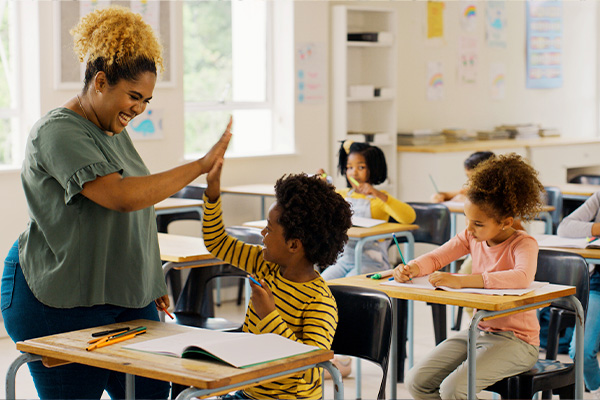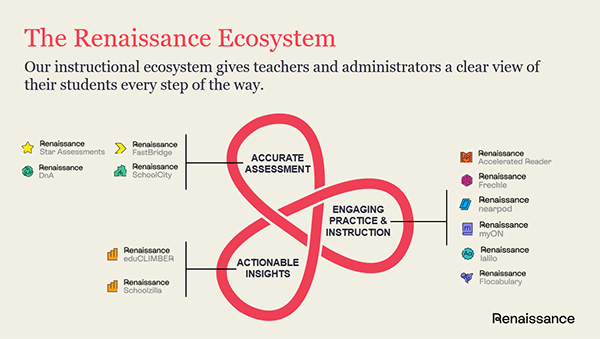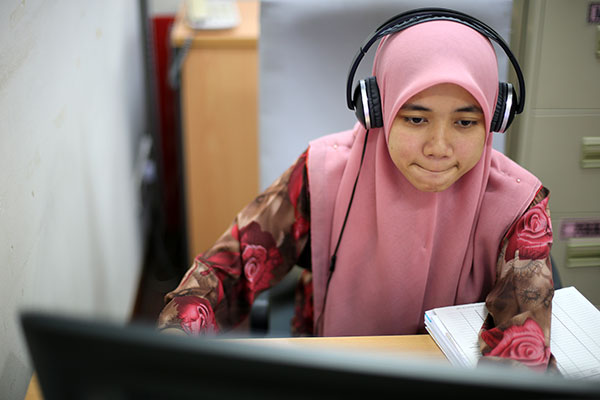August 7, 2023
For more than 35 years, educators have relied on Renaissance for tools and insights to support the important work they do each day. While technology has changed greatly over the decades, our commitment to helping educators to truly, fully see every student remains the same.
To accomplish this, we provide an ecosystem of interconnected solutions to give educators a clear view of students’ strengths and needs from pre-K through grade 12. This includes:
- Accurate Assessment, to measure student learning and growth
- Engaging Practice & Instruction, to ensure students build the skills they need for success
- Actionable Insights, to improve learning outcomes and inform decision making
We recently had the opportunity to discuss the Renaissance Ecosystem with Todd Brekhus, Chief Product Officer at Renaissance and General Manager of Nearpod. Highlights from our conversation appear below.

What is the Renaissance Ecosystem? When did the ecosystem launch?
Todd Brekhus: The Renaissance Ecosystem has a long history, dating back to the mid-1990s. At that time, schools had been using Accelerated Reader for nearly a decade, and we had reading data for millions of students. We asked ourselves how we could use this data to help educators better understand where their students are now, where they’re likely to be by the year’s end, and the next best steps to take to improve outcomes for every learner.
This led to the development of ATOS, an easy-to-understand scale for identifying a text’s complexity, and Star Reading, an extremely efficient and reliable assessment of students’ reading comprehension. This was, in a sense, the first iteration of the Renaissance Ecosystem, which integrated assessment and practice data to support instructional planning, streamline goal setting, and show educators whether students were on track for success.
This was helpful information for educators to have. It became vital when No Child Left Behind became law in the early 2000s. We realized that we could use interim assessment data from Star to predict how students were likely to perform on state accountability assessments. This use of algorithms to forecast state test performance empowered educators to intervene early to support students who were struggling. In fact, adequate yearly progress in Star became one of the most popular and effective ways to predict and measure student growth and learning outcomes—in both literacy and math.
Of course, the Renaissance Ecosystem continued to expand over the years in response to educators’ and students’ needs. The addition of myON, for example, provided students with instant access to thousands of digital books and news articles, along with embedded reading and writing tools. This brought an important new experience into the ecosystem—digital reading—as well as powerful new insights for educators on students’ reading habits and engagement.
myON also brought millions of additional data points into the ecosystem, helping us to further refine our understanding of how students learn and grow within and across school years. This enables us to make even smarter recommendations for differentiating instruction and practice, so educators can more easily target the skills that are most essential for students’ progress and better engage every learner.
This is very much the model we’ve followed as we’ve further expanded the ecosystem to include Freckle, Lalilo, Nearpod, FastBridge, and more. Each addition not only brings rich new content and experiences for students and teachers, but also a wealth of data to further enhance our understanding of how students learn best.

Why do we use the term “Renaissance Ecosystem?” What specifically does this term bring?
Todd Brekhus: “Ecosystem” is a widely used term in the software industry, describing programs that are used together and evolve together in the same environment. It’s also a term that’s familiar to educators—whether they’ve taught middle school science or not. It’s an apt metaphor, because in an ecosystem, each plant or animal has its unique place but is also connected to and interacts with all of the others over its lifecycle.
The same is true of our Renaissance Ecosystem. For example, Accelerated Reader and myON are better when they’re used together, allowing students to seamlessly move from reading a book to taking the associated AR quiz and seeing their progress toward their goals. But it never occurred to us to “merge” AR into myON, or vice versa. Each offers a unique student experience, and each has its own place in the ecosystem.
At the same time, AR and myON connect to each other (and to Star Assessments), and this interconnectedness is critical. In the early 2000s, we were one of the first edtech providers to move from the old client-server software model to a web-based model. This allowed for a lot of innovation, but we were still reliant on physical data centers, and a lot of manual work was necessary, for example, when districts asked us to share their Star data with their state DOE.
Over the last seven years, we’ve moved to the cloud, which gives us much greater scalability and eliminates those data siloes. This allows us to quickly bring additional tools and resources into the ecosystem and to connect them with the tools and resources that educators are already using. It also allows us—through Renaissance Analytics—to give building and district administrators powerful insights into student performance and growth, with the ability to easily disaggregate and drill into data in ways they never have before.
We chose the word “ecosystem” to highlight all of these points. You’ll sometimes hear the term “tree of life” used for a biological ecosystem—a number of unique experiences coming together to create a single, interconnected system. Renaissance provides something similar, where a number of unique learning experiences—reading a digital book in myON, taking an Accelerated Reader quiz, mastering a math objective in Freckle, completing an interactive lesson in Nearpod—all point back to one place, giving educators a more complete picture of every student.

What makes the Renaissance Ecosystem unique? How does the ecosystem benefit teachers and students?
Todd Brekhus: It’s important to understand the difference between personalized learning—a term we hear a lot—and personalized teaching and learning.
Other edtech vendors’ ecosystems usually start with a diagnostic test, which is used to place students onto a prescribed learning pathway. So, you end up with classrooms where every student is doing their own thing, following their own pathway, which may or may not connect to what the teacher is doing. This is often called “personalized learning,” but it isn’t, really. It’s a lot closer to the experience many of us have probably had of completing an online tutorial, where you’re constantly clicking the “Next” button to advance to the next screen, and you’re presented with a quiz at the end to see what you’ve retained.
Needless to say, education is not about clicking the “Next” button all day—a point that was really driven home during the COVID-19 pandemic. With school buildings closed, many students were stuck on their screens, trying to self-learn with minimal guidance, little interaction with peers, and no real awareness of where they were going. This is not 21st-century learning and is not an effective use of technology.
Our approach at Renaissance is the opposite one. We provide in-the-moment insights and access to a wide array of learning resources so that teachers can easily adapt and tailor instruction to their students’ needs—without spending hours on planning or having to manually reconcile data from multiple sources. Let me give you an example:
When we brought Freckle into the Renaissance Ecosystem, our first step was to map all of Freckle’s math objectives, activities, and resources onto our math learning progression. Our learning progressions are our ecosystem’s “backbone,” showing the progression of skills from pre-K through high school and aligned with every state’s standards of learning. Each program within the ecosystem is tightly mapped to our learning progressions, so that every activity a student completes points back to the same place, as I mentioned earlier.
This means that once students complete a Star Math assessment, teachers can easily see each student’s current location on the learning progression. They can then go into Freckle and easily find resources for the particular skill that each student, small group, or class is ready to learn, and they can assign that skill with a single click for targeted practice.
Freckle also offers adaptive pathways, so students can work at their own level and at their own pace. It’s this flexibility—the option of providing both targeted and adaptive practice to students at the same time—that sets our ecosystem apart and shows how we keep the teacher (not the algorithm) at the center of the classroom. And with each type of practice, students are doing much more than clicking “Next.” Freckle includes embedded supports, colorful graphics, real-world activities, and some really fun challenges to keep students engaged and to encourage peer interaction as they apply and build on what they’re learning.
Driving effective differentiation
Discover how the Renaissance Ecosystem will help you to better engage every learner.
Why is Nearpod such an important part of the Renaissance Ecosystem? How does Nearpod support differentiated instruction?
Todd Brekhus: What Nearpod brings is really magical, in terms of sparking students’ curiosity. If you watch an engaged Nearpod classroom, you’ll see a wide variety of learning activities. For example, one group of students may be working on a simulation, where they’re applying a math concept that they learned recently. Another group may be rewatching a video, gathering evidence to support an argument. A third group may be working on a science project exploring the environmental impact of something, or looking at causes and effects, or comparing two scientific theories.
In each case, you’ll see students collaborating with each other and with their teacher—asking questions, sharing ideas, weighing evidence, and making connections. This is the richness of real instruction delivered by a real teacher, using Nearpod’s formative data and huge library of resources to engage students, to get them talking with their peers, and to help them to think critically. This is 21st-century learning, and it’s the opposite of the “sit and get” model I described earlier.
To make this process even easier, we’ve created a Star-to-Nearpod connection. As teachers review their Star data, they’re able to access aligned instructional resources in Nearpod with the click of a button. Assigning the right resources to individual students, small groups, or a whole class is an equally seamless process. If you’re using Star Assessments, you have access to this feature now, regardless of whether you’ve used Nearpod before. We’re currently working on a FastBridge-to-Nearpod connection, which will support differentiation in a very similar way.
I’d be remiss if I didn’t also mention Flocabulary here. Flocabulary complements Nearpod by using music and beats and memory to help students learn the fundamentals. Yes, we all have access to Google, but there are some things that students just need to know in order to evaluate an argument, solve a problem, or understand a concept. And Flocabulary is really effective at helping students to learn vocabulary, language arts skills, math facts, science, and more. Mastering the fundamentals opens up so many learning opportunities, as students become curious about a topic and want to go deeper.
Clearly, I could talk about Nearpod for hours, and I can’t emphasize enough how it’s helping educators to deliver engaging, collaborative, and pedagogically sound instruction. I’m especially proud of the recently released Nearpod Math program, which provides so many additional tools and resources, and truly represents our approach to personalized teaching and learning.

How are educators responding to the Renaissance Ecosystem? What are we planning for the future?
Todd Brekhus: The most common response is, “Wow—you’re clearly going in a different direction than the other edtech providers.” Decades of research have confirmed the massive importance that having access to a high quality teacher has on students’ success. And educators recognize that our ecosystem isn’t built on the outdated “drill and kill” approach but rather on amplifying what good teachers are already doing—and giving them insights, resources, and tools to be even more effective, spark even greater student curiosity, and really improve learning outcomes for all.
Educators also appreciate the fact that the Renaissance Ecosystem is open. Our eduCLIMBER platform, for example, offers more than 200 connections to enable districts to review data on attendance, academics, social-emotional behavior (SEB), interventions, and more to get really powerful, whole child insights to drive decision making. Similarly, the Nearpod library includes lessons and resources not only from Renaissance but from a wide variety of publishers and curriculum providers to support effective differentiation.
As a company, we’ve always believed that students learn better when we all work together, and this is something that educators understand and respond to.
In terms of future direction, we’re excited to launch what we’re tentatively calling our Teacher Journey. Just as Renaissance Analytics gives administrators powerful district- and school-level insights, the Teacher Journey will show teachers how their students are doing right now, using data from across the ecosystem. In some cases, students may be struggling and may require remediation, and teachers will have instant access to lessons and resources to help. In other cases, students will be ready for more of a challenge to promote deeper learning—and teachers will have access to resources for these learners as well.
Providing teachers with insights in the moment to help them match each student with the right supports at the right time for success. This is probably the best one-sentence description of the Renaissance Ecosystem I can provide, and it perfectly captures how, as an organization, we live our mission of accelerating learning for all.
Learn more
Connect with an expert to discover how the Renaissance Ecosystem can help you to effectively differentiate instruction and practice this year.

